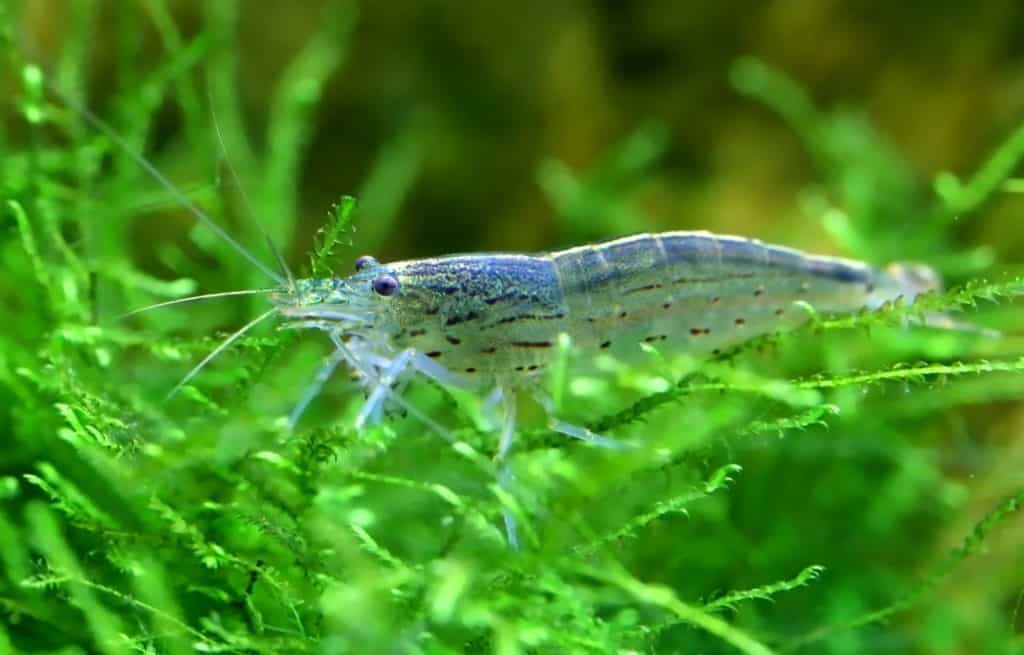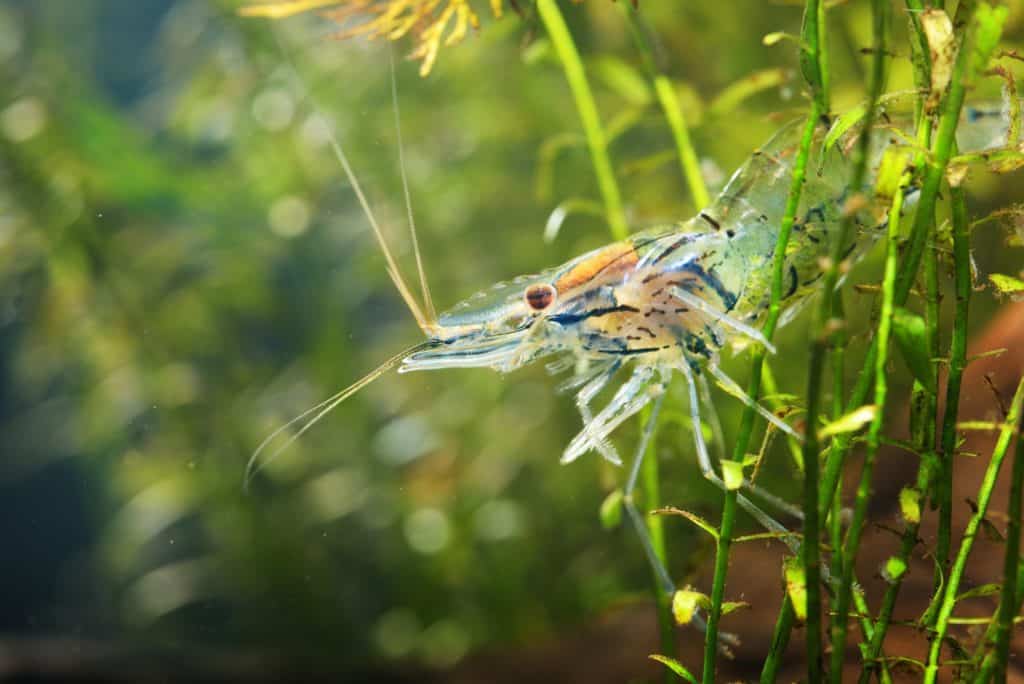
Amano shrimp are one of the most popular shrimp species for aquariums.
Some hobbyists keep them for fun, but mostly, they keep Amano shrimp for their tank cleaning abilities.
If you want healthy and happy shrimp that do their jobs well, you need to know how many to keep in your tank.
This post will explain why you shouldn’t under/overstock Amano shrimp and give you additional facts about problems you may face if doing so.
How Many Amano Shrimp Per Gallon?

You need around two to three gallons per shrimp.
A group of three to four Amano shrimp can be acceptable if you have a small tank, but it’s better to keep at least half a dozen together if you have the space.
This way, you’ll prevent any dominant behavior among them.
The smallest decent tank size is ten gallons for Amano shrimp.
They grow up to two inches, so three or four of them can live happily in ten gallons of water.
For five to six shrimp, you’ll need a 20-gallon tank.
It’s best to add two or three gallons for any additional shrimp you introduce to the tank.
Remember to keep both males and females.
Amano shrimp need their space to live well.
They’re social creatures and like to be in groups.
Otherwise, they’ll become too shy and hide most of the time while experiencing stress.
If you overcrowd your tank with other fish, you’ll cause too much stress.
You’ll also need to pay more attention to the shrimp’s optimal water conditions to decrease the chance of them getting sick.
Overstocking can also cause too much waste, and this will bring up some health issues.
You’ll need to be aware of the symptoms before any massive damage is done.
On the other hand, if you put too many Amano shrimp in the tank, they’ll wipe out the algae quickly, and they’ll be left starving.
You should think of a proper food source before putting more than a few of these creatures together in a tank.
Plus, putting too many Amano shrimp in a community tank can sometimes threaten other species.
Amano shrimp are docile and friendly creatures by nature, but they can get carried away if their numbers are large.
Type and Number of Tankmates

The number of other species in the tank is as important as the number of Amano shrimp.
They should all have their space so you can have a peaceful and healthy tank.
Amano shrimp are docile and peaceful by nature, and if you keep them in standard numbers, they won’t pose a threat to other fish.
However, you must consider that they’re small and defenseless, so they can easily fall prey to other fish.
You can keep Amano shrimp with small and peaceful fish.
Any fish that’s big enough to devour the shrimp in a bite should be off your list.
Aggressive or carnivorous fish can be dangerous as well.
Keep Amano shrimp with Neon Tetras, Cory and Otocinclus catfish, Guppies, Tiger Barbs, and other small and peaceful fish.
Snails like Nerite or Malaysian snails and other small shrimp types like Cherry shrimp and Ghost shrimp can make great tankmates.
Do not, however, put them in a tank with Crayfish, Cichlids, Goldfish, Plecos, Gourami, Bettas, Oscars, Arowanas, and freshwater lobsters.
Won’t Amano Shrimp Breed and Multiply?

If you’re thinking about adding two or three Amano shrimp with the hope of them breeding, you’re bound to be disappointed!
That’ll most probably never happen because Amano shrimp need specific conditions to breed in.
Amano larvae need to be transferred to saltwater within 48 hours of the mother releasing them into the water, or they’ll die.
After one or two months, the baby shrimp should go back to freshwater to survive.
As you can see, breeding them is a challenging task, so much so that even professional fish keepers run into problems.
This is why the Amano shrimp you buy are mostly wild-caught and more expensive than most other shrimp species.
Water Conditions

Before introducing the shrimp to your tank, you should check the water parameters, especially if you have a crowded aquarium.
Amano shrimp prefer the water temperature to be between 70 and 80°F.
As adults, they can’t withstand brackish water, so you should keep the pH around 6.5–7.5.
Much like all other invertebrates, shrimp are more sensitive to nitrogen compounds like ammonia and nitrites.
These chemicals are usually non-existent in well-established and cycled aquariums, but you should check just to be sure.
The nitrate levels should be as low as possible, up to 20 ppm at most.
Beware of copper levels in your tank because any excess amount can quickly affect Amano shrimp and kill them.
These shrimp will live better if you change their water regularly.
Amano shrimp won’t produce much bio load, but they can get hurt from bad water quality if they live with other fish species.
They’re most vulnerable when they’re molting, which is the process of shedding their exoskeleton.
They’ll need hiding places during this time, especially if they live in a crowded community, so be sure to provide them with live plants, rocks, and shrimp tubes.
Diet

Amano shrimp are omnivores and will eat any leftover food that sinks to the bottom of the tank, and most types of algae.
This is probably why you bought them in the first place, but this shouldn’t be their main diet, as they can’t get all the minerals they need from algae.
You should feed them with supplemental food like nutritious sinking pellets and algae wafers.
They also love frozen food like bloodworms, brine shrimp, and vegetables like zucchini, cucumbers, squash, and spinach.
Remove any excess food from the tank after they’re done eating because it can quickly turn bad in the water.
Amano shrimp won’t consume algae as much as you need them to if they’re eating other food types.
If you notice them not eating as much algae as before, feed them less.
This can become a problem in community tanks with other types of fish, especially if you keep Amano shrimp in larger groups than normal.
In this situation, they’ll feel comfortable enough to eat other fish’s food, and even fight for it!
Don’t overcrowd your aquarium with Amano shrimp thinking they’ll just eat more algae.
Note that they won’t eat black beard algae.
They’ll also eat dead fish or shrimp, so try to remove the bodies from the tank as soon as possible.
If they died from sickness or infection, your shrimp would be sick after eating the carcass.
Health Issues

If you overcrowd your tank with Amano shrimp but don’t do frequent water changes or use proper filtering, your shrimp will catch diseases and infections.
Bacterial infections can occur in most shrimp species, and Amano shrimp are no exception.
If you don’t maintain a clean tank, your shrimp may all die from this illness.
Because of their transparent bodies, you can see their internal organs turning pink, black, or white.
You can also spot inflamed organs.
There’s not much you can do if this happens.
The best way is to separate the sick shrimp from the tank, put them in a hospital tank, and give them salt baths.
This way, other fish and shrimp won’t become infected.
Another disease caused by bad water conditions is Vorticella.
Vorticella are small organisms that attach themselves to live creatures like shrimp and feed on bacteria.
In the process, they can multiply in large numbers and form a colony, leading to the shrimp’s death.
The best way to fight this disease is to perform regular water changes and give the infected shrimp salt baths.
Imposters

Suppose you’re thinking about adding to your Amano shrimp population because algae remain in your tank.
In that case, you should first consider the possibility that those shrimp are not Amano!
This is especially likely if you haven’t bought your shrimp from a reliable seller.
Some members of the shrimp family have the same physical appearance as Amano shrimp.
Sometimes they can get caught in the nets, and even professionals can’t recognize them from their looks.
What sets them apart is that they’re a little bit smaller, and as opposed to Amano shrimp, they can breed in freshwater.
Most importantly, they’re lazy and won’t eat algae as fast and as relentlessly as Amano shrimp.
Frequently Asked Questions

1. How Long Do Amano Shrimp Live?
Amano shrimp usually live up to two to three years.
Because they’re sensitive shrimp, some may die in the first few weeks after you introduce them to a new tank and environment.
If they manage to live past that, you can expect them to live for a long time.
Some Amano shrimp can live up to five or six years in a tank with good care and water conditions.
2. Will Amano Shrimp Climb Out of the Tank?
Amano shrimp usually won’t climb out of the tank if they’re satisfied with their living conditions.
However, as they’re sensitive shrimp, they can climb or jump out of the tank if any sudden changes occur in the water parameters.



Leave a Reply
You must be logged in to post a comment.